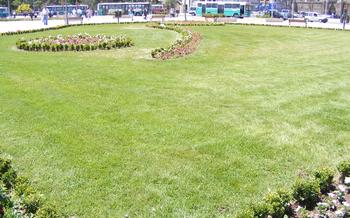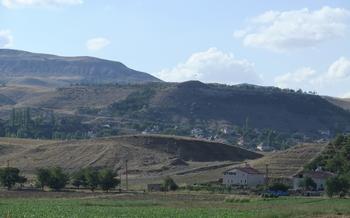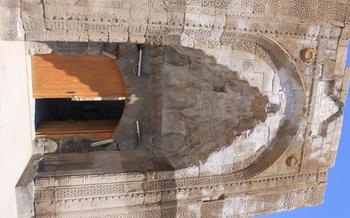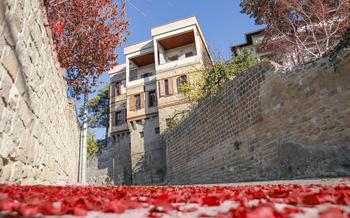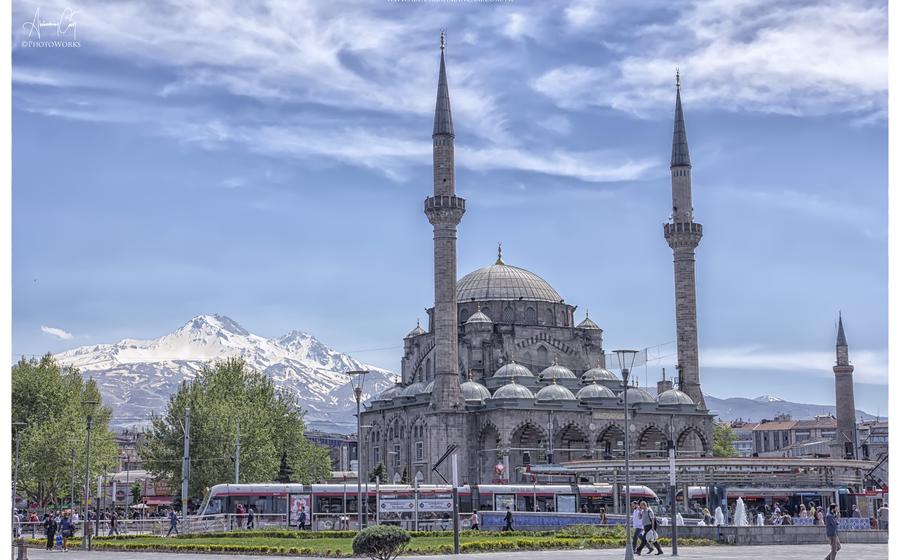
Cifte Kümbetler
- The Double Tombs: An Enigmatic Masterpiece
- History and Architecture: A Blend of Seljuk and Anatolian Traditions
- The Tombs in Context: Exploring Kayseri's Rich History
- Admission, Timings, and Facilities
- Unveiling the Archaeological Marvels: A Detailed Exploration
- Capturing the Essence: Photography Tips and Tricks
- The Legacy of the Cifte Kümbetler: A Lasting Impression
- Beyond the Tombs: Discovering Kayseri's Culinary Delights
- The Mausoleum of Haci Kılıç: A Hidden Gem Nearby
- A Glimpse into Seljuk Craftsmanship: The Art of Stone Carving
- The Caravanserai of Sultan Han: A Journey Back in Time
- Kayseri's Vibrant Festivals: A Celebration of Culture and Tradition
- Insider Tip: Unveiling the Hidden Chamber
The Double Tombs: An Enigmatic Masterpiece
The Cifte Kümbetler, meaning "Double Tombs," stand as enigmatic masterpieces in Kayseri, Turkey. Their unique architectural style and intriguing history have captivated visitors for centuries. While the identities of their builders remain shrouded in mystery, the tombs' striking features and historical significance make them a must-visit destination for anyone seeking to delve into Turkey's rich cultural heritage.
Unveiling the mystery behind the builders of the tombs:
The Cifte Kümbetler were built in the 13th century, during the reign of the Seljuk Sultanate. However, the exact identities of their builders remain unknown, adding to the tombs' mystique. Some theories attribute their construction to the Seljuk Sultan Alaeddin Keykubad I, while others suggest that they were built by his wife, Mahperi Hatun. Regardless of their creators, the tombs' intricate design and exceptional craftsmanship showcase the remarkable skills of the Seljuk artisans.
Exploring the architectural marvel and its unique features:
The Cifte Kümbetler comprise two identical octagonal tombs, each adorned with exquisite carvings and intricate tilework. Their striking turquoise color, which has weathered beautifully over the centuries, sets them apart from other Seljuk monuments. The tombs' double-layered domes, supported by elegant columns, create a sense of grandeur and symmetry. The meticulously carved doorways, adorned with geometric patterns and vegetal motifs, provide a glimpse into the artistic prowess of the Seljuk era.
Understanding the historical significance of the site:
The Cifte Kümbetler hold significant historical value as they represent the transition from the Seljuk to the Ottoman architectural styles. Their unique design, blending Islamic and Anatolian elements, showcases the cultural and architectural influences that shaped the region during this period. Moreover, the tombs offer insights into the funerary practices and beliefs of the Seljuk dynasty, providing valuable clues to their understanding of life, death, and the afterlife.
Getting a glimpse into the lives of the people buried here:
While the identities of those buried in the Cifte Kümbetler remain uncertain, it is believed that they were high-ranking officials or members of the Seljuk royal family. The tombs' opulent design and elaborate decoration suggest that they were individuals of great importance and wealth. Exploring the tombs offers a glimpse into the lives of these influential figures, shedding light on their social status, cultural practices, and religious beliefs.
History and Architecture: A Blend of Seljuk and Anatolian Traditions
The Cifte Kümbetler stand as a testament to the architectural prowess of the Seljuk dynasty, seamlessly blending Seljuk and Anatolian design elements. The tombs showcase the evolution of Seljuk architecture, representing a transitional phase between the earlier, simpler structures and the later, more elaborate ones. The octagonal shape of the tombs, a unique feature in Seljuk architecture, is believed to have been influenced by Byzantine and Armenian influences. The intricate carvings and decorations adorning the exterior reflect the Seljuk love for ornamentation and craftsmanship. Islamic motifs, such as geometric patterns and Kufic inscriptions, are interwoven with traditional Anatolian symbols, creating a harmonious blend of cultural influences.
The construction techniques employed in the Cifte Kümbetler demonstrate the advanced engineering skills of the Seljuk builders. The use of cut stone and mortar, along with careful attention to structural stability, ensured the longevity of these monuments. The domes, a defining feature of Seljuk architecture, are constructed using the squinch technique, allowing for a smooth transition from the square base to the circular dome. The use of materials such as limestone and sandstone, sourced from the nearby quarries, reflects the builders' understanding of local resources and their ability to utilize them effectively.
The Tombs in Context: Exploring Kayseri's Rich History
The Cifte Kümbetler are not just isolated monuments but are deeply embedded in the rich tapestry of Kayseri's history. The city has a storied past that stretches back to ancient times, and its strategic location has made it a crossroads of cultures and civilizations.
Kayseri was once a thriving center of the Seljuk Empire, and its architectural heritage reflects this glorious era. The city is home to numerous historical landmarks, including the Hunat Hatun Complex, the Sahabiye Medresesi, and the Kayseri Castle. These monuments showcase the architectural prowess of the Seljuks and provide a glimpse into their cultural and religious beliefs.
In addition to its Seljuk legacy, Kayseri has also been influenced by various other cultures, including the Romans, Byzantines, and Ottomans. This diverse heritage is reflected in the city's architecture, cuisine, and customs.
Kayseri's location on the Silk Road made it a hub of trade and commerce. Caravans from all over the world passed through the city, bringing with them goods, ideas, and cultural influences. This vibrant exchange of ideas helped shape Kayseri's unique identity.
The city's rich history is also reflected in its vibrant local culture and traditions. Kayseri is renowned for its hospitality, its traditional crafts, and its delicious cuisine. Visitors to the city can immerse themselves in the local culture by exploring the bazaars, sampling the local delicacies, and participating in traditional festivals and events.
Admission, Timings, and Facilities
Before embarking on your visit to the Cifte Kümbetler, it's essential to plan and prepare for a seamless experience. Here's a comprehensive guide to admission, timings, and available facilities:
Admission Fees: - Standard admission fees apply for both domestic and international visitors. - Fees may vary based on the time of year and special events. - Check the official website or local tourism offices for the most up-to-date admission prices.
Timings: - The Cifte Kümbetler typically follow regular opening hours throughout the week. - Timings may vary during public holidays or special occasions. - It's advisable to visit during daylight hours to fully appreciate the architectural details and surroundings.
Guided Tours: - Guided tours are available for those who wish to delve deeper into the history and significance of the site. - Tours are often conducted in multiple languages to accommodate international visitors. - Inquire about guided tour options when purchasing your admission ticket.
Visitor Services: - Basic facilities such as restrooms and drinking water are available on-site. - A small gift shop offers souvenirs and informational booklets about the Cifte Kümbetler. - Parking facilities are available in the vicinity of the site.
Special Events: - The Cifte Kümbetler occasionally hosts special events, festivals, and exhibitions. - Check local event calendars or inquire with tourism offices for information on upcoming events.
By planning your visit and being aware of the available facilities, you can optimize your experience at the Cifte Kümbetler and make the most of your time exploring this historical gem.
Unveiling the Archaeological Marvels: A Detailed Exploration
The Cifte Kümbetler has been the subject of extensive archaeological excavations, which have unearthed a wealth of artifacts and inscriptions that have shed light on the history and significance of the site. These excavations have revealed the remains of earlier structures that predate the tombs, suggesting that the site has been a place of religious and cultural importance for centuries.
Among the most significant findings are the inscriptions found on the tombs, which provide valuable information about the builders and the people buried here. These inscriptions have helped to identify the tombs as belonging to two brothers, Şahzade Ahmet and Şahzade Mustafa, who were sons of the Seljuk sultan Alaeddin Keykubad I. The inscriptions also reveal that the tombs were built in 1275, making them some of the earliest examples of Seljuk architecture in Anatolia.
The excavations have also uncovered a number of artifacts, including pottery, coins, and jewelry, which provide insights into the daily lives of the people who lived here. These artifacts have been carefully preserved and are now on display in the Kayseri Archaeological Museum, where visitors can learn more about the history and culture of the Seljuk period.
Capturing the Essence: Photography Tips and Tricks
The Cifte Kümbetler offers a photographer's paradise with its captivating architecture, intricate carvings, and serene surroundings. To capture the essence of this historical marvel, here are some photography tips and tricks:
-
Mastering the Light: The interplay of light and shadow adds depth and drama to your shots. Visit during the golden hours of sunrise or sunset to capture the warm, soft light that enhances the tombs' beauty.
-
Experiment with Angles: Don't limit yourself to straightforward shots. Experiment with different angles to create unique perspectives. Try capturing the tombs from below to emphasize their grandeur or from a distance to showcase their harmonious blend with the landscape.
-
Focus on Details: The Cifte Kümbetler is adorned with exquisite carvings and intricate tilework. Get close-up shots to capture these details, showcasing the craftsmanship and artistry of the Seljuk masters.
-
Utilize Natural Elements: Incorporate the surrounding elements into your composition. The lush gardens, towering trees, and distant mountains add depth and context to your photos.
-
Embrace Symmetry: The tombs' symmetrical design offers a perfect opportunity for visually pleasing compositions. Position yourself directly in front to capture the perfect symmetry, creating a sense of balance and harmony in your shot.
The Legacy of the Cifte Kümbetler: A Lasting Impression
The Cifte Kümbetler's legacy extends far beyond their physical existence. These mausoleums have left an indelible mark on architecture and art, inspiring and influencing countless structures throughout history. Their unique design, intricate carvings, and historical significance have made them a source of fascination and admiration for centuries.
The Cifte Kümbetler's influence can be seen in the evolution of tomb designs throughout the region. Many later tombs and mausoleums incorporated elements inspired by these iconic structures, such as the use of twin domes and elaborate carvings. The tombs' architectural style became a symbol of power and prestige, and was adopted by various rulers and dynasties.
Beyond architecture, the Cifte Kümbetler have also had a profound impact on the cultural heritage of Turkey. They represent a significant chapter in the country's history and are a testament to the skill and artistry of the Seljuk craftsmen. The tombs have become a symbol of Kayseri and are a source of pride for the local community.
Preserving and promoting this unique site is of utmost importance. The Cifte Kümbetler stand as a reminder of the rich cultural heritage of Turkey and the enduring legacy of the Seljuk dynasty. By safeguarding and sharing this architectural marvel with future generations, we can ensure that its story continues to inspire and captivate for centuries to come.
Beyond the Tombs: Discovering Kayseri's Culinary Delights
Beyond the historical and architectural wonders of Kayseri, visitors can embark on a culinary journey to savor the delectable flavors of traditional Turkish cuisine. The city is renowned for its rich culinary heritage, offering a diverse range of dishes that tantalize the taste buds.
Indulge in the vibrant local markets, where the air is filled with the aroma of fresh spices and produce. Explore the keşkek restaurants, specializing in the iconic dish of keşkek, a hearty wheat and meat stew that is a staple of Kayseri's cuisine.
Don't miss the opportunity to savor mantı, the Turkish ravioli, which is a local delicacy. These small dumplings, filled with ground beef or lamb and topped with yogurt and tomato sauce, are a culinary delight that will leave you craving for more.
Kayseri's street food scene is not to be missed. Discover the unique flavors of gözleme, a savory pastry filled with cheese, spinach, or potatoes, or indulge in the crispy delight of çiğ börek, a deep-fried pastry filled with herbs and cheese.
As you explore Kayseri's culinary delights, embrace the opportunity to interact with the friendly locals and learn about their rich culinary traditions. Whether you prefer a leisurely meal at a traditional restaurant or a quick bite on the go, Kayseri's food scene has something to offer every palate.
The Mausoleum of Haci Kılıç: A Hidden Gem Nearby
Just a short distance from the Cifte Kümbetler, another architectural gem awaits discovery: the Mausoleum of Haci Kılıç. Often overlooked by tourists, this hidden gem offers a glimpse into the rich artistic heritage of Kayseri.
Dating back to the 13th century, the mausoleum is a testament to the exquisite craftsmanship of the Seljuk era. Its exterior facade is adorned with intricate carvings and tilework, showcasing the skill and artistry of the Seljuk craftsmen. The interior of the mausoleum is equally impressive, with its serene atmosphere and beautifully preserved decorations.
While the identity of Haci Kılıç remains a mystery, the mausoleum stands as a testament to his importance and influence during the Seljuk period. Its proximity to the Cifte Kümbetler suggests a possible connection between the two sites, adding to the intrigue surrounding this hidden gem.
Visiting the Mausoleum of Haci Kılıç is a must for anyone interested in exploring the lesser-known architectural wonders of Kayseri. Its unique features and historical significance make it a worthwhile destination for those seeking to delve deeper into the city's rich cultural heritage.
A Glimpse into Seljuk Craftsmanship: The Art of Stone Carving
The Cifte Kümbetler showcases the exquisite stone carving techniques that were a hallmark of Seljuk craftsmanship. The intricate carvings adorning the exterior walls and portals depict a variety of motifs, including geometric patterns, vegetal designs, and calligraphic inscriptions. These carvings not only enhance the visual appeal of the tombs but also hold symbolic and religious significance.
The geometric patterns, often featuring stars and octagons, represent the harmony and order of the universe. The vegetal designs, such as vines and flowers, symbolize the cycle of life and the connection between the earthly and spiritual realms. The calligraphic inscriptions, often verses from the Quran, serve as reminders of the religious beliefs and devotion of the builders.
The skill and artistry of the Seljuk craftsmen are evident in the precision and detail of the carvings. Each element is carefully crafted and arranged to create a harmonious and visually stunning composition. The intricate stone carvings of the Cifte Kümbetler stand as a testament to the exceptional craftsmanship and artistic legacy of the Seljuk era.
The Caravanserai of Sultan Han: A Journey Back in Time
Just a short distance from the Cifte Kümbetler, travelers can step back in time as they explore the Caravanserai of Sultan Han. This magnificent structure, built in the 13th century, served as a resting place for weary travelers and traders along the Silk Road. With its imposing facade, vast courtyard, and intricate architectural details, Sultan Han stands as a testament to the grandeur of the Seljuk era.
As you enter the caravanserai, you'll be transported to a bygone era, where merchants from distant lands exchanged goods and stories. The vast courtyard, once bustling with activity, is now a tranquil space where you can soak in the atmosphere of history. The surrounding rooms, once used by travelers for shelter and repose, now stand empty, inviting you to imagine the lives that unfolded within these walls.
Admire the intricate stone carvings that adorn the caravanserai, showcasing the skill and artistry of Seljuk craftsmen. These carvings depict scenes from everyday life, as well as motifs and symbols that hold deep cultural significance. Take a moment to appreciate the architectural features of the caravanserai, such as the pointed arches, domed roofs, and iwans (vaulted halls).
Sultan Han is not just a historical monument; it's a place where the past comes alive. As you wander through its chambers, you can almost hear the echoes of laughter, conversation, and the clinking of coins. Let your imagination soar as you picture the hustle and bustle of the Silk Road, with travelers from far-off lands converging at this caravanserai to share stories, trade goods, and experience the wonders of the ancient world.
Kayseri's Vibrant Festivals: A Celebration of Culture and Tradition
Kayseri is not just home to historical landmarks but also a vibrant cultural scene. Throughout the year, the city hosts a variety of festivals and events that showcase its rich heritage and traditions.
One of the most popular festivals is the Kayseri Erciyes International Winter Festival. Held annually in January, this festival celebrates the winter season with a range of activities, including snow sports, concerts, and cultural performances. Visitors can enjoy skiing, snowboarding, and ice skating on the slopes of Mount Erciyes, while also experiencing the warmth of Turkish hospitality.
Another notable event is the Kayseri Ahi Evran Culture and Art Festival. This festival, held in June, pays tribute to Ahi Evran, a 13th-century Turkish philosopher and mystic who founded the Ahi brotherhood, a guild of artisans and merchants. The festival features traditional Turkish music, dance, and handicrafts, providing a glimpse into the city's rich cultural heritage.
Visitors to Kayseri during these festivals can immerse themselves in the local culture, interact with friendly locals, and create lasting memories. Be sure to check the festival dates in advance and plan your trip accordingly to fully experience the vibrant atmosphere of Kayseri's celebrations.
Insider Tip: Unveiling the Hidden Chamber
Beyond the visible splendor of the Cifte Kümbetler, a hidden chamber lies concealed, waiting to be discovered by curious travelers. This secret space, located beneath the tombs, adds an aura of mystery and intrigue to the site.
The existence of the hidden chamber has been known for centuries, but its exact purpose remains a subject of speculation. Some believe it was used as a treasury to store valuable artifacts and treasures. Others suggest it served as a secret meeting place for Sufi mystics or as a refuge during times of danger.
To uncover this hidden gem, visitors must descend a narrow staircase tucked away in a corner of the tombs. The chamber itself is small and dimly lit, with rough-hewn walls and a low ceiling. Despite its humble appearance, it exudes an atmosphere of secrecy and seclusion.
Exploring the hidden chamber is like embarking on a journey through time. Visitors can imagine the footsteps of ancient figures who once tread these hidden spaces, engaging in clandestine activities or seeking refuge from the outside world.
Unveiling the hidden chamber beneath the Cifte Kümbetler is a unique and unforgettable experience. It offers a glimpse into the hidden depths of history and adds an extra layer of intrigue to this already captivating site.

